
This is the machine that helped spawn a generation of kids who were massively into their machines, as well as a demo scene that's still going to this day. When it was released in the summer of 1985 it was an absolutely outstanding machine - 4096 colour pallette, stereo sound AND a graphical user interface (GUI) that featured an environment similar to the Apple Lisa and Macintosh also known as WIMP - Windows, Icons, Mouse Program. There was nothing like it around at the time, but boy did it cost! The basic machine was well over £1500 and couldn't drive a TV - you either needed the Amiga monitor, had to suffer composite video output or bought the extra TV modulator. (All of the above reasons are why I didn't buy one!)
The A1000 was originally 'just' the Commodore Amiga. It was the brainchild of one Jay Miner, who used to work for Atari where he designed the Atari 400/800 and the legendary VCS. When Atari wouldn't let him design the next machine around the Motorola 68000 processor (same as used in the Apple Lisa and Macintosh) he jumped ship and went to work for a small Californian company called Amiga Inc who were designing a primarily games machine called the Lorraine. Jay's input resulted in 3 seperate chips being used for the 3 main functions of the machine, to take the load off the CPU. "Denise" did the graphics, "Agnus" did memory management, blitter tasks etc and "Paula" did sound. Pictures of the breadboard prototype are on the web, most likely at Cameron Kaiser's 'Secret
Weapons of Commodore'.
The operating system for the new machine, AmigaDOS, was written by a small company within Bristol University in the UK called MetaComCo, who specialised in the 68000 CPU and had previously written an OS called Tripos....I need to check but I'm pretty sure AmigaDOS was based on Tripos. Tim King, who was part of MetaComCo has given me an Amiga Phone :)
Once word got round both Atari and Commodore entered a bidding war to buy Amiga Inc, and Commodore won much to Atari's annoyance and lawsuits, since they reckoned they had proper claim to the chipset that was in the Amiga machine.
However, Commodore still won the day, the Amiga was released and Atari was pretty much finished in the state it was in. In a strange twist of events, Jack Tramiel (Commodore head honcho) left and bought what was left of Atari. The first machine of the 'new' Atari was the 520ST, a machine that spookily was built round the Motorola 68000......despite the fact it was a poorer cousin to the Amiga, the ST was much cheaper, and the wars really broke out between the kids when Commodore released the Amiga 500, and we were right back to 'C64 is crap'/'naah Spectrum is crap' days :)
Oh, the inside of the top lid of the Amiga has the signatures of all the people who worked on it embossed on in the same fashion as most compact Apple Macs (Mac, Mac Plus, SE, Classic etc), as well as a paw print from Jay Miner's dog - see pics!
This machine was the result of a trade with Danish collector Thomas Hillebrandt, and didn't survive the journey across the sea, but a bit of TLC plus a couple of complete stripdown and rebuilds soon had it back in working order. I love the message when you start Notepad that says 'Looking for fonts. Are you there, fonts?' (last pic). Great :o)
Here's a mail from Martin Scott Goldberg after he'd surprised me with the info about Jay Miner having a hand in the design of the Atari VCS:
"Yes, both the VCS and the PCS (Personal Computer System - the name for
the
Atari 400 and 800 computers). The Amiga was actually the next Atari
computer and the next Atari computer (ST series) was actually the next
Commodore one. Meaning each one used the legacy of the previous
generation's design considerations. The Amiga (according to Joe Decuir,
who desinged the Amiga bus and several of the chips, and was a co-designer
of the Atari VCS and PCS's) was based on the same philosophy of
multi-processor design. Meaning seperate custom processors for sound,
graphics, etc., which is what they did with the Atari 8 bits originally as
well. The ST meanwhile used the same design considerations as the
Commodore 8 bits (vic 20, and 64, not the pets) - cheap, off the shelf
parts giving the most power possible for as little cost as possible."
Atari 400 and 800 computers). The Amiga was actually the next Atari
computer and the next Atari computer (ST series) was actually the next
Commodore one. Meaning each one used the legacy of the previous
generation's design considerations. The Amiga (according to Joe Decuir,
who desinged the Amiga bus and several of the chips, and was a co-designer
of the Atari VCS and PCS's) was based on the same philosophy of
multi-processor design. Meaning seperate custom processors for sound,
graphics, etc., which is what they did with the Atari 8 bits originally as
well. The ST meanwhile used the same design considerations as the
Commodore 8 bits (vic 20, and 64, not the pets) - cheap, off the shelf
parts giving the most power possible for as little cost as possible."
"Interestingly, the original SIO bus (the network setup on the Atari 8
bits
that allowed the attachment of multiple "intelligent" peripherals in
succession on the same link) had a lasting legacy as well. When Joe wound
up at Microsoft years later, he was on the consortium team from Microsoft
that designed the USB bus. He used the work he and Jay did on the SIO as
a model."
that allowed the attachment of multiple "intelligent" peripherals in
succession on the same link) had a lasting legacy as well. When Joe wound
up at Microsoft years later, he was on the consortium team from Microsoft
that designed the USB bus. He used the work he and Jay did on the SIO as
a model."
Another email, this time from Pete Gordon:
"I think Martin Scott Goldberg's bit in the A1000 section is wrong.
The Amiga could be considered the spiritual successor to both the Atari 8 bits, or the C64. His specific quote is:
"The ST meanwhile used the same design considerations as the Commodore 8 bits (vic 20, and 64, not the pets) - cheap, off the shelf parts giving the most power possible for as little cost as possible"
Bzzzzt! The Commodore 64 had a custom chipset (SID, VIC, and VIA chips) to take strain off the CPU, which worked in a very similar way to the Atari 8-bit equivalents (POKEY, GTIA).
The reason the C64 was relatively cheap was that Commodore owned MOS technologies; who happened to have a chip fabrication plant. All of the main chips in the C64 were manufactured in house, so Commodore could do it much cheaper. The SID and VIC are by no means "off the shelf".
Commodore designed the VIC-I in the late 70s/early 80s as a "games console" video chip, but had difficulty finding a buyer, so decided to use the chip themselves in a system, and the "VIC-20" was born.
When the VIC was updated to the VIC-II for the C64, they moved sound out to a seperate chip (SID), and improved the resolution and abilities of the chip.
The ST, however, was entirely made of off the shelf parts. It didn't even have a blitter at first! The poor 68000 had to do everything. Hardly a spiritual successor of the C64!"
The Amiga could be considered the spiritual successor to both the Atari 8 bits, or the C64. His specific quote is:
"The ST meanwhile used the same design considerations as the Commodore 8 bits (vic 20, and 64, not the pets) - cheap, off the shelf parts giving the most power possible for as little cost as possible"
Bzzzzt! The Commodore 64 had a custom chipset (SID, VIC, and VIA chips) to take strain off the CPU, which worked in a very similar way to the Atari 8-bit equivalents (POKEY, GTIA).
The reason the C64 was relatively cheap was that Commodore owned MOS technologies; who happened to have a chip fabrication plant. All of the main chips in the C64 were manufactured in house, so Commodore could do it much cheaper. The SID and VIC are by no means "off the shelf".
Commodore designed the VIC-I in the late 70s/early 80s as a "games console" video chip, but had difficulty finding a buyer, so decided to use the chip themselves in a system, and the "VIC-20" was born.
When the VIC was updated to the VIC-II for the C64, they moved sound out to a seperate chip (SID), and improved the resolution and abilities of the chip.
The ST, however, was entirely made of off the shelf parts. It didn't even have a blitter at first! The poor 68000 had to do everything. Hardly a spiritual successor of the C64!"
Update after a visit from Rich "dragondata.co.uk" Harding - my A1000 now has a box to live in. Ta! It's not in the best condition, but how often do you see A1000 boxes?
Pictures
 | 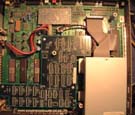 |  |  |
 |  | 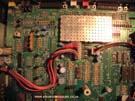 |  |
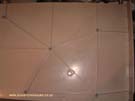 |  |  | |
 |  |  | |
 | 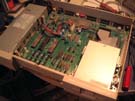 | 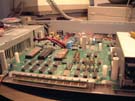 |  |